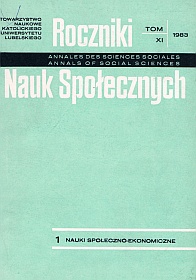Socjologia rytuału religijnego. Zarys problematyki
Abstrakt
The religious ritual is an underestimated field of sociological studies. On the one hand this situation results from long-voiced prejudice against folk religiousness which is very strongly associated with the religious ritual, and on the other hand it results from the opinion that in modern industrial societies the ritual is a dying-out phenomenon. It turned out, however, that despite socio-cultural changes, often very rapid and profound, the religious ritual either preserves its original character or its forms are changed, but it does not disappear.
The present paper presents an outline of the problems of the religious ritual within the perspective of humanistic sociology and against the background of other types of rituals. The task proved difficult in view of a limited number of comparative material and the difficulty in separating the religious ritual from other rituals.
The study of the religious ritual was divided into four parts. The first focuses on theoretical and methodological assumptions in the study in the ritual. The starting point was the concept of „real" man with particular consideration of symbolic dimension. A broad definition of the ritual was made including the definition of the religious ritual. In order to find a formal aspect of the problem the sociology of the ritual was considered a subdiscipline of sociology and given separate attention.
The second part is concerned with the separation of the religious ritual from a range of other rituals. A typology of rituals was made (religious, aesthetic, civil-social rituals and the rituals of the cycles and crises of life), however, as this turned out to be insufficient a division into religious and secular rituals was introduced. The criterion of this division is ritual practices’ relation to sacrum and profanum. Other detailed criteria were analysed to differentiate between the religious ritual and other types of rituals (the kind of symbols used, implications of the rituals affecting other fields of life).
The third part deals with the religious ritual only. Most attention was given to religious experience, the religious ritual being one of the forms of its expression. The primeval religious experience requires objectivization and routinization and hence, the author made an analysis of the institutionalization of the religious ritual. The functions of the ritual were divided into two groups: religious and social. To the former the following were included: the function of deepening the ties with sacrum, deepening the religious ties among the participants in the ritual and moral renewal of the individual and the religious group. From among the latter only the integration function was discussed.
Part four included analyses of spontaneous factors like secularization, pluralism, industrialization, urbanization, and planned factors like controlled secularization, reform in the liturgy which affect changes in the religious ritual. Next, lism, industrialization, urbanization, and planned factors like controlled secularireligious rituals themselves. With reard to the former a change in the position of sacrum was underlined; with the latter, disappearance of sacrum in mixed rituals was noted. The author gives some hypotheses of the changes basing on the research made by Polish ethnographers and sociologists with the hypothesis of the more and more private character of the religious ritual as the most significant.
The present paper is the first attempt to view the religious ritual in a broader perspective. This attempt is not an exhaustive one, nevertheless it can inspire sociologists to develop the studies in the rituals. It can also be of some use for participants in rituals and for priests.
Copyright (c) 1983 Roczniki Nauk Społecznych

Utwór dostępny jest na licencji Creative Commons Uznanie autorstwa – Użycie niekomercyjne – Bez utworów zależnych 4.0 Międzynarodowe.


